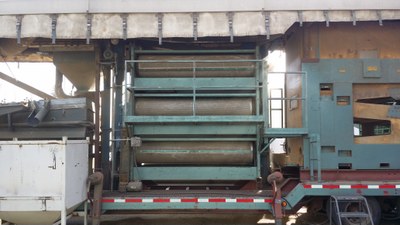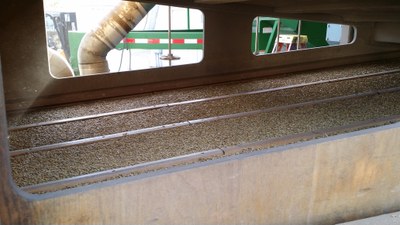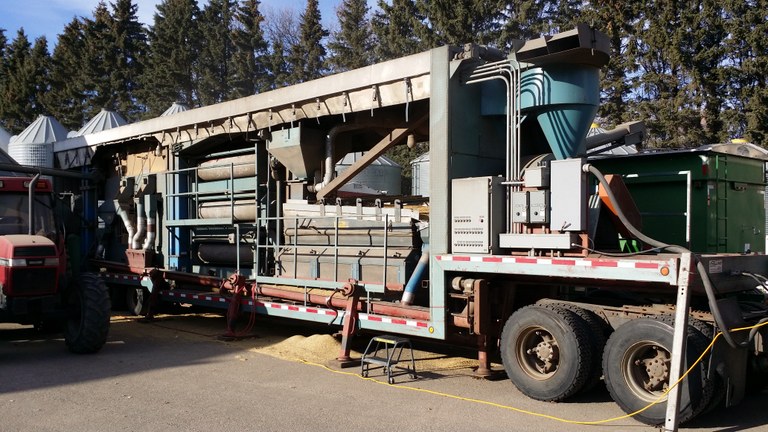Conditioning Seed
With all of our Seedstocks crops off the field, our attention is now focused on conditioning seed for planting next spring.
The NDSU Agronomy Seed Farm in Casselton led the process to have the mobile mill designed and constructed on behalf of the NDSU Foundation Seedstocks program. The mobile mill has three different styles of cleaners contained in one 53-foot, curtain-side trailer. We use this mobile mill, capable of cleaning 300 bushels per hour, during the mid to late weeks each fall to condition 50,000 - 60,000 bushels of spring wheat, barley, durum, buckwheat, and soybeans for the coming planting season.
(CREC’s in-house mill, constructed in the early 1962, cleans about 30 bushels an hour, and is used to clean field peas before the mobile mill arrives. Flax is cleaned in-house, too, because the mobile mill doesn’t have special screens required for the flat, oval shape of flaxseed. Typically the in-house mill runs until late March or early April shortly before spring planting.)
When the mobile mill arrives at CREC, it is inspected to make certain everything is in working order. Set up includes positioning six outriggers to stabilize and level the trailer. A semi-tractor pulls the unit on the highway, but a separate diesel generator powers all of the conveyors, augers, pulleys, fans, brushes, and electrical switches and gauges required to operate the mill.
Seed grains are handled as carefully and as gently as possible to preserve the vital germ from which the sprout will grow. Instead of using augers which could crush kernels, conveyors are used to carry the seed, and drop distances are minimized whenever possible.
Sifter Sieve
Conveyors lift bin-run grain into the back of mill, where seed enters the top the first cleaner, an air screen with large, flat screen-tables (sieves) with round or slotted holes. The top sieve, called a ‘scalper’ sieve, allows grain to pass through round holes, while straw and other large impurities are pulled out by a steady air flow. Each of the lower ‘sifter’ sieves have elongated slots rather than round holes, so broken kernels and small weed seeds fall through the slots and collect at the bottom of this cleaner. Sieves are set at an incline, and as the sieves shake and bounce, the clean grain gradually bounces/falls/moves to a conveyor at one end. To keep sieves clear of debris and operating at peak efficiency, brushes constantly slide back and forth across the bottom side of each screen. Screenings such as broken, small, or undeveloped kernels are augered to a waiting truck, while the partially-cleaned seed moves to the next cleaner, an indent cylinder machine, via another conveyor.
Indent Cylinder
 The indent cylinder cleaner features a “six pack” of drums, two stacks of three inclined horizontal rotating cylindrical screens. (The duplicate stacks facilitate cleaning twice the volume.) The inside of each drum is covered with tiny indents, or pockets. Each series of indent cylinder machines is designed to separate seed by length, using a combination of pocket size, rotation speed (which cause a centrifugal force), friction and gravity. By using screens with a specific pocket size, same-size particles nestle into the pockets and are lifted as the drum rotates. Friction and centrifugal force hold the particles in place, but as the cylinder turns, particles are lifted to a point where gravity takes over and kernels fall onto a collection trough where an internal conveyor pan/shelf catches the grain as it tumbles from the upper inside edge of the drum. Differing sizes of drums collect different lengths of seed, with rotation speed dictating the point that the seed falls to the pan. Desirable seed is captured either by collection within the drum, or by capturing undesirable items with the drum and allowing good seed to pass through. Again, screenings are augered out and cleaner(er) grain is conveyed to the next phase.
The indent cylinder cleaner features a “six pack” of drums, two stacks of three inclined horizontal rotating cylindrical screens. (The duplicate stacks facilitate cleaning twice the volume.) The inside of each drum is covered with tiny indents, or pockets. Each series of indent cylinder machines is designed to separate seed by length, using a combination of pocket size, rotation speed (which cause a centrifugal force), friction and gravity. By using screens with a specific pocket size, same-size particles nestle into the pockets and are lifted as the drum rotates. Friction and centrifugal force hold the particles in place, but as the cylinder turns, particles are lifted to a point where gravity takes over and kernels fall onto a collection trough where an internal conveyor pan/shelf catches the grain as it tumbles from the upper inside edge of the drum. Differing sizes of drums collect different lengths of seed, with rotation speed dictating the point that the seed falls to the pan. Desirable seed is captured either by collection within the drum, or by capturing undesirable items with the drum and allowing good seed to pass through. Again, screenings are augered out and cleaner(er) grain is conveyed to the next phase.
The final cleaner on the mobile mill is a gravity table, used to separate heavier seed from identically-sized seed of lesser weight. Here, flat inclined screens shake as a fan blows from underneath the screen. Heavier particles are lifted a shorter distance and travel uphill as the lighter materials float higher and longer and fall downstream, where they are separated off.
Gravity Table
While screen and slot size determine the type and size of seed cleaned, the one constant, though the operation of all of these cleaners, is fine adjustment. A few pounds of air pressure, a few RPM’s (revolutions per minute) on a drum, a few degrees of inclination, or a few millimeters difference in pocket size, all make a tremendous difference as to what is saved or scrapped.
Ultimately, barley screenings are fed to cattle involved in research projects at the CREC Livestock Unit. Other screenings are sold on the open market at local elevators.
Clean seed is stored in hopper bins or totes or bagged for storage on pallets, waiting for spring planting.
Dave Copenhaver
Foundation Seedstocks Research Spec.




